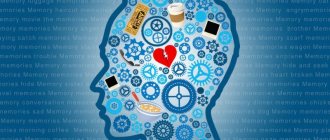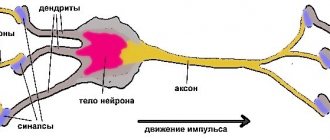Now mnemonics for memory development are used everywhere: in kindergartens, schools, universities, trainings, educational courses. Many believe that these are the latest techniques to avoid senility and excessive forgetfulness. However, few people know that this is an ancient Greek word (derived from the name of the goddess of memory Mnemosyne) and a science that Aristotle, Giordano Bruno, Alexander the Great, Julius Caesar, and Napoleon Bonaparte were fond of. So what are these methods of memorizing information, how effective are they in practice, and how to master them?
What it is
Mnemonics, or mnemonics, is a science that teaches the art of memorization using certain techniques and methods. Its task is to improve memory through associations. She rejects rote learning, which has already shown its ineffectiveness. Which adult remembers Tatyana's letter to Onegin by heart? Units! And all because this information has no significance for the majority and is not tied to objects or sensations.
Mnemonics is a technique for memorizing information when various objects and facts are closely associated with ideas in a person’s head. They can be visual, auditory or kinesthetic. This simplifies the memorization process and increases memory capacity. The simplest example: from childhood, everyone remembers the order in which the colors in the rainbow are located, thanks to the saying about the hunter and the pheasant. The initial letter of each color is associated with the initial letter of the words in that phrase. This is one of the main techniques of mnemonics. In this way, any information can be imprinted in memory.
In mnemonics, two objects of memorization are used - numbers and words. Even if the task is to remember a picture, it must first be mentally transformed through associations into a list or some kind of phrase.
Exercises for children and teenagers
Until the age of 14, a child develops abstract logical thinking and remembers best what he personally experiences. Mnemonics allows you to connect associations from life experience with abstract concepts from the curriculum. Thus, the process of memorization and learning as a whole is simplified.
Next, we will look at the most accessible and effective methods.
Story method
This technique is suitable when a child needs to remember a series of words that are absolutely unrelated to each other. To do this, you should imagine their meanings in your imagination and come up with a story using them. The funnier or more fantastic the story, the simpler and better it will be remembered. The technique is suitable even for younger schoolchildren.
Let's look at an example. Let's take a list of words:
- Bee.
- Rain.
- Sofa.
- Pan.
- Borsch.
- Tulip.
- Postman.
- Tiger.
- Corn.
- Toothbrush.
Let's try to invent a story with these words.
Postman Pechkin rode on a tiger through a corn field. Out of nowhere a swarm of bees , but then it started to rain and dispersed them all. The rain was magical, and instead of corn, tulips . Then Pechkin noticed a tent in the middle of the field. a sofa in it , and borscht in the stove . And sticking out of it was not a ladle, but a toothbrush .
In this way, you can compose a story from a list of products, names of school subjects, plans for the weekend, etc.
Chain method
The task is to combine several images into a single chain. It is important to ensure that all words are consistent.
For example, let's take the following words: horse, daisies, sandwich, chess, history, chimpanzee. Let's see how you can create a chain from them.
The horse , bathing in the grass with daisies , chewed a sandwich and watched how and chimpanzees taught history chess .
As you can see, words are strung onto a sentence like beads on a string. It is enough to remember the first word. The rest will follow on their own.
Cicero's method
Other common names for this technique are “Roman Room Method” and “Mnemonic Room”. Why, exactly, Cicero? This ancient Roman politician and orator never used cheat sheets and could reproduce many quotes, facts, names and historical dates from memory.
When Cicero prepared for speeches, he walked around the house and mentally placed the key points of his speech on each object.
So, the essence of the method:
- You need to choose a room. This could be a room in your apartment or an auditorium where you are planning a performance.
- Then you need to attach a unit of information to each item: a keyword, a sentence or a whole thought. It is better to do this by moving your gaze clockwise. This will make it easier to remember.
- During the performance, it is enough to remember the situation in the rehearsal room. The necessary information will emerge in memory by itself.
More and more new images can be attached to the same location. But from time to time it is better to change the room so that the information does not get confused.
This technique can use not only rooms, but also the road from home to school, for example. Pay attention to what you see: a bench, an urn, a lantern, a store, three birch trees, a gate, a flowerbed, etc. Attach images from the information you remember to each object, and during the story, recreate the entire path in your memory.
Mnemonics techniques
To understand the basics of mnemonics, you first need to get acquainted with its main tools - techniques that allow you to remember almost any information.
By initial letters
We have already seen one example of this technique above. Used if you need to remember several words in a certain sequence (colors in a rainbow, planets by distance from the Sun). Their initial letters are taken and a phrase is invented that is completely unrelated to their topic, but the words in it begin with the same letters. When you need to reproduce information, you first remember the composed sentence, which serves as an excellent hint. There are ready-made templates for similar phrases for each individual sequence (examples will be below), but you can create your own.
Rhymes
Rhyming as a mnemonic technique is suitable for developing memory in creative people who love poetry and successfully rhyme words. Or you can use already prepared templates, as in the previous case.
Consonances
When you need to remember complex, long terms or foreign words, simple and understandable consonances are invented for them and stored in memory. For example, in medicine there are the concepts of “supination” and “pronation”, which refer to movements of the hands in different directions. In order not to forget them, students, future doctors, are offered similar sound equivalents - “she carried soup and spilled it.”
Visualization
A technique based specifically on visual associations. To remember any information, a certain picture is created in the head. For example, it’s easier for women to learn car brands: Jaguar is a big wild spotted cat, Audi is wedding rings, etc. This technique is especially good for developing visual memory.
Visual associations
Spatial imagination
The famous method of Cicero, which once again proves how ancient science mnemonics is. A person who puts this technique into practice treats his own memory as a separate space. It could be a museum, a library, storage facilities, or just a room. It has many shelves, chests, and compartments. It is recommended to present the memorized information in the form of an expensive vase or an ancient scroll and put it away in a certain place. When you need to reproduce it, an invented association arises in your mind, and it can be “extracted” from one or another suitcase without any problems.
Visual memory
A widely used method by Aivazovsky, which involves memorizing details. Another mnemonic technique that works to develop primarily visual and even photographic memory. One of the exercises is to closely but imperceptibly look at your interlocutor and then accurately reproduce him from memory, down to every button and mole.
Digital algorithms
These techniques are designed primarily to develop the memory of scientists and people associated with the exact sciences. Due to the nature of their work, they have to memorize long formulas and numbers. This can be done quite easily if you find some patterns or correlate them with familiar, memorable dates.
Use abbreviations
In life, we often use various letter abbreviations that we associate with the full name. The method, when only the first letter or part remains of each word, is suitable for memorizing long phrases, names, terms, the components of which are not logically connected.
Example:
We need to remember the list of products that we need to buy on the way home: apples, mayonnaise, oranges, tomatoes, bleach, arugula. To do this, you can group words into several abbreviations that are easy to remember. For example, it might look like this: MOUTH and PIT.
If the list is a little shorter, you can use parts of words rather than letters to form a memorable word. So, if you need to remember the words “pasta” and “lemon,” you can add the first syllables of the words and remember them as LIMA. Association with the capital of Peru will allow you to quickly remember what exactly you need to take in the store.
Methods
Since mnemonics did not appear yesterday, it includes various techniques, each of which offers the use of its own methods of memorizing information and memory training. Beginners may find them too complicated. In fact, if you understand their algorithm and master at least one, it will greatly simplify your life. We bring to your attention some of the most famous mnemonic systems.
Alphanumeric alphabet
The abbreviated name is CBA. Author unknown.
A technique according to which each number is associated with a specific letter through visual or auditory association. There are clearly written alphabets that need to be memorized and put into practice. You can create your own.
Alphanumeric code
The abbreviated name is BCC. The author is V. Kozarenko, a well-known specialist in mnemonics, who has written many textbooks on it.
The system of memorization and memory development proposed by Kozarenko is similar to the previous one. But here, first you just need to memorize the correspondence between numbers and paired consonant letters without any associations, and then use them in life. His BCC looks like this:
- 0 — m/n;
- 1 - g/f;
- 2 - d/t;
- 3 - farm;
- 4 - h/sh;
- 5 — p/b;
- 6 - sh/l;
- 7 — s/z;
- 8 - v/f;
- 9 - r/ts.
How to use. For example, you keep track of your income and expenses, you spent 2,056 rubles in a store, and you need to remember it in order to record it at home. You come up with a word that has a consonant corresponding to each number, and make a sentence out of them. 2 - children, 0 - ice cream, 5 - ice cream, 6 - chocolate. The children ate ice cream, it was ice cream and chocolate. There is no need to set a goal to come up with something conscious and logical. The more unusual the phrase, the better it will be remembered.
Other methods are also used in mnemonics:
- Fractional Number Code (FNC) - for those who deal with mathematics.
- Development of visual memory through visual associations. For example, each line of a memorized poem (a number in a formula) is “nailed” on a particular house (or tree) on the way to work or to the store and is repeated every time you walk along it.
- Method of auxiliary objects: if you put your finger on the Moon, you can understand whether it is growing or aging, depending on the resulting letter (P or S).
- Development of sound memory: chants (for learning Morse code), rhymes (“One Hundred Chinese Surnames”, Perelman’s dialogue about circles for memorizing the number Pi).
There are a large number of memory systems in mnemonics. You need to choose what suits you. If you have nothing to do with mathematics, KDC and Perelman’s dialogue are of no use to you. Look for those techniques that are relevant specifically to your life. Also focus on your memory type. You can first begin to perfect the one that prevails in you, and then develop the one that is worse.
Memorizing numbers and figures
The techniques described below are suitable for memorizing information such as telephone and car numbers, historical dates, mathematical and natural science constants, etc.
Alphanumeric code. The alphanumeric code is one of the most popular (and ancient) mnemonics. This technique is based on the fact that each number is assigned a specific letter. To remember large numbers, words, phrases, sentences, or even short stories are made from such letters.
We will demonstrate the operation of this mnemonic technique with an example. Below is a alphanumeric code, which is based on the correspondence between the consonant sounds with which most numbers begin, and, in fact, the numbers themselves from 0 to 9.
0 1 2 3 4 5 6 7 8 9 n r (“one”) d t h p sh s v m (“many”, because “d” is already occupied by the number 2)
To freely use the alphanumeric code, you need to learn this table very well, you need to know it no worse than the multiplication table. And in order to remember any number, for example, 739812, you need to do the following:
- Divide our number into pairs of numbers: 73-98-12.
- After this, you need to recode the numbers into words: the first consonant in the word is the first digit of a two-digit number, and the second consonant must correspond to the second digit using the alphanumeric code. For the number “73” (letters “s” and “t”) you can make words: set, honeycomb, hundred, sieve and others. For numbers 9 and 8 we will compose the word MaVr, and for numbers 1 and 2 - Raduga.
- Now the composed words denoting pairs of numbers must be used to create a specific story, for example, “One hundred MaVrov saw Raduga.”
Take phone memorization training using mnemonics:
Statistics Full screen
The hanger method or memorizing numbers using the method of linked associations. The hanger word method is based on visual representations and allows you to remember a list consisting of any number of numbers in the correct order. To do this, you need to assign ten so-called hanger words to each number and remember these words well. And in order to memorize a number consisting of several digits, you need to link the images of the digits of this number with some kind of story. For example, if you assign number 1 the image of an athlete, and number 5 the image of a school, then number 15 can be remembered as the story of an athlete participating in school competitions.
Combining numbers with images. This mnemonic device is based on the idea that each number has a shape (what it looks like when written), and this shape can remind you of the shapes of some objects that can be used as hanger words. Zero: circle, ball, sun. Unit: crowbar, lantern, straw. And so on. And as in the hanger method, when memorizing a number, all its numbers must be connected into some kind of story.
O'Brien's method. This mnemonic device is also a modification of the hanger method. Dominic O'Brien suggests using images of famous people to remember numbers.
Each two-digit number should be assigned a certain celebrity and its characteristic action, and for each single-digit number any simple association should be selected by appearance, meaning or consonance (1 - pencil (by appearance), 3 - pig (by meaning, i.e. k. you know the fairy tale about the three little pigs), 7 – seeds (according to consonance).
It is important to remember well the correspondences for each number, both from 0 to 9, and for all the others, starting from 10, so that they are firmly entrenched in the mind. Using O'Brien's technique, it is easy to create images for numbers from 00 to 99; accordingly, one image can even have four digits.
It is also very convenient to replace the numbers 0 and from 3 to 9 with the first letters of their names (0 - H, 3 - T, 8 - V, etc.), then focusing on consonances. For example, 88 – Vladimir Vladimirovich, 65 – ShaPoklyak, 87 – Vysotsky, 99 – DzhigurDa. And the numbers 1 and 2 can be replaced by K and L, respectively (K is a pencil (1), L is a swan (2). It turns out that, for example, 52 is Plushenko.
But here’s a more complicated example: let’s say you need to remember the PIN code for your card - 5592. This is very simple to do: 99 is our DzhigurDa, and 52 is Plushenko. Thus, having modified the image, we get that 9952 is Dzhigurda on skates (as an option - Plushenko on skates holds Dzhigurda in his arms).
It is worth noting that it is better not to overuse the three modifications of the hanger word method described above. If you use similar methods, it is better to choose one of them that seems most convenient to you. Otherwise, you risk getting confused in the large number of created images and resulting chains of associations.
If you need to remember some numbers for a long time, then you can use the following mnemonics:
Association with other familiar numbers. Dale Carnegie advises remembering dates by associating them with significant dates that you know. For example, it is easy to remember that the Battle of Kulikovo took place exactly 600 years before the Summer Olympic Games in Moscow.
Shedd system (Shed system). Small numbers, for example, historical dates or short telephone numbers, can be learned by composing a special phrase, each word in which is in a strictly defined order and has the number of letters corresponding to the memorized number. For example, if you want to remember the number 467, then you need to come up with a phrase in which the first word will consist of 4 letters, the second - of 6, and the third word - of 7 letters. Thus, the number 467 corresponds to the phrase “an elephant gallops” (4, 6 and 7 letters, respectively). A zero in this system often corresponds to a word of 10 or any number of letters.
Rhymes. It is often convenient to memorize a large number of numbers by creating rhymes or poems. This method is suitable if you need to remember certain numbers for a long time, having the opportunity to spend some time on it. This way you can easily remember which signs come after the decimal point in the number “Pi”.
Kinds
If you plan to use mnemonics, keep one important point in mind. This is a whole science that has developed over several centuries. It has a rich history of development and there are many directions in it. In the same books dedicated to this art, they are often intertwined with each other. The authors offer sets of exercises, some of which relate to folk techniques, others to the classics. Such heterogeneity leads to the absence of a system.
Don't step on this rake. Choose one of the areas in accordance with your goals, objectives and individual characteristics and master it first. If things go well, then continue practicing using a different method.
Folk
The techniques of folk mnemonics are familiar to most people, as they have become firmly established in their lives, and many do not even suspect it. These are those rhymes with exceptions to the rules that they learned at school, the phrase about the hunter and the pheasant with the colors of the rainbow that set the teeth on edge. Road signs on the street, symbols on a computer desktop, the alphabet - these are all codes for developing memory in order to better remember and reproduce the necessary information faster.
Acrostic
Someone comes up with their own systems for learning a foreign language or chemical reactions, telephone numbers or significant dates - all this reflects the essence of everyday, or folk, mnemonics.
Classical
This is the very first system of mnemonics that has come down to us in written form. It dates back to 86 BC. e. At that time it was an integral part of rhetoric. Speakers used it to deliver long speeches accurately and without hesitation.
One of the most striking examples is Cicero's method. His opponent was Quintilian; he advocated for those people who had poorly developed visual and associative memory and who could not use Cicero’s technique. Quintilian proposed other alternatives to storing information, but was unable to formalize them into a separate system. However, it was they who later became the basis for the development of pedagogical mnemonics.
Pedagogical
The antipode of classical mnemonics. It finally took shape only in the 16th century, thanks to the Cambridge University teacher P. Ramus. This direction was closer to ordinary people, so it became widespread. There was no need to make complex visual associations here. Her main techniques were:
- repeated reading of the text and repeating it out loud;
- taking notes;
- redrawing illustrations;
- play activities;
- creation of didactics.
Methods of pedagogical mnemonics are still used in the modern education system.
Circus
The second name is variety. A narrow circle of people (it all started with circus troupes) creates its own system for coding the material. Anything can be used: language, gestures, facial expressions, intonation. The task is to transfer information from the assistant to the performer so cunningly that no one notices. These techniques are now actively used by scammers, telepaths, and psychics.
Sports
Since 1997, mnemonics competitions have been held annually in Cambridge. This direction has special specifics. Each participant is a guru in a specific area. Some reproduce binary numbers from memory, others recite poems 300 pages long by heart. As a rule, the winners end up in the Guinness Book of Records. The best in their field are determined by two indicators: memorization speed and volume.
Modern
The main representative of this direction is the Giordano mnemonic system. It is quite complex, based on scientific research in neurobiology about the brain and memory as a higher mental function. Here are just some of its provisions:
- development of electrical (neural) memory;
- mental operation “Connecting images”;
- the concepts of “Memorization Meaning” and “Accurate Information”;
- associations consisting of a foundation and auxiliary elements;
- system of internal stimulation of the cerebral hemispheres;
- multi-level schemes of reference images;
- constant training of memorization skills.
Mnemonic rule for remembering the number of days in a month using your knuckles
Don't remember what happened 5 minutes ago? Our short-term memory is to blame for this. What it is and ways to improve it is in our separate article.
Mnemonics
In two words, mnemonics is the art of memorization. Mnemonics are techniques and methods of memorization.
Some effective methods have been known to you since childhood. Acrostic method helps the student remember the colors of the rainbow once and for all. Every Hunter Wants to Know Where the Pheasant Sits. The first letter of each word in this nursery rhyme is the same letter as the color of the rainbow. And everyone knows that the rainbow has seven colors: red, orange, yellow, green, blue, indigo, violet.
Using this technique, our ancestors learned the letters of the alphabet. Now this verse is not used, because the letters are already called differently.
Mnemonic phrases help you remember the rules of syntax: putting on clothes, putting on Nadezhda. I can't bear to get married.
A bisector is a rat that runs around the corners and divides the corner in half. These nursery rhymes will help us understand how mnemonics work.
In order to remember well, mnemonics experts advise using a system of images or associations . This is how Einstein's name is associated with physics. The name Ivan sounds similar to sofa. The number eleven is similar in appearance to drumsticks and Chinese chopsticks. Love is associated with the heart.
The story writing method helps you remember unrelated words. Eg:
- A pineapple;
- Drum;
- Crocodile;
- Fan;
- Brick.
Let's come up with a funny story about how a pineapple played a drum, the crocodile didn't like it, he ran towards the drum, but the fan blew him out of the way, and the crocodile hit a brick.
Moreover, the more crazy the story, the sooner it will be remembered.
Very close to this technique is Chain . It involves putting images in a chain in your mind. The pineapple is holding a drum, the crocodile is biting the drum, a fan is hanging on its tail, and a brick is lying at the foot of the fan.
By imagining such a funny picture in your mind, you will quickly remember five words. In the same way you can memorize 10, 20, 100 unfamiliar words.
The most advanced method of memorization is considered to be the Location method . To use it, you should remember in your mind the familiar furnishings of your apartment and designate for yourself all the places with some number. The front door will be number 1, a rug with a pair of shoes will be 2, a cassette with clean shoes will be 3, a coat rack will be 4, a shelf for hats will be 5.
If we now attach a pineapple to the door, put a drum on the rug, put a crocodile in the cassette, hang a fan on a hanger and hide a brick on the shelf between the hats, we will also remember these words that we heard recently for the first time.
You can also think about the route you take every day to work.
Examples of practical application
Mnemonics are often used to memorize rules, formulas, and numerical values in various sciences. First of all, it's a great memory workout. Secondly, it is ideal for children to fully master the school curriculum in individual subjects. Those who were lucky enough to study with teachers familiar with these methods forever remembered the exception words in the Russian language, the Pythagorean theorem in geometry, and many other truths that ideally everyone should know by heart. If teachers do not have the skills to work with these techniques, parents can use them themselves to help their child learn.
Some of the most striking examples of mnemonic techniques in different academic disciplines will help you.
How to work with them. Almost all of them are based on the techniques of rhyming and consonance. So, all children need to do is memorize funny rhymes - and the rules themselves will be remembered almost for the rest of their lives. You'll see: they will read them to their grandchildren later.
Russian language
Mathematics
Other items
Similar techniques and methods of mnemonics exist for almost all academic disciplines and spheres of life:
- in music - to remember the sequence of notes;
- in traffic rules;
- in military affairs (formulas for hit accuracy taking into account side winds and target speed);
- in the transport sector (colors of navigation lights on board aircraft and ships);
- in telephony (numbers where numbers are replaced by letters corresponding to them on the telephone keypad).
Mnemonics are invaluable when learning a foreign language. It will make the task easier for schoolchildren, students, and adults. The OPSHACOM rule, for example, will make it much easier to understand and remember the canonical order of placing several adjectives before a noun in English.
How to master
Firstly, you can take mnemonics lessons from specialists who are closely involved in applying its systems and techniques in practice. They can be found on the Internet: buy a training course, sign up for an online training, arrange lessons via Skype. There are a huge number of ways to master it.
Secondly, you can learn mnemonics yourself, at home. However, please note that this will be a longer journey than with a specialist. Some techniques may seem too complicated, and then there is a risk of giving up without developing your memory. Sometimes regularity and perseverance are not enough. When there is a teacher, there is a schedule of classes, assignments, etc. But here you only have to rely on self-discipline.
To learn mnemonics yourself, you need to start by choosing:
- directions (it is better for a beginner to choose folk or pedagogical, rather than modern or classical);
- the type of memory you will be developing;
- the technique that you can master best (rhymes, consonances, visual associations);
- the author's system in which you will work.
Next, you need to set aside a specific time for studying. It is best to do this immediately before bed. For beginners, these steps will be enough.
To-do lists and calendar in your head
To become a winner in any game, you first need to know its rules. And if you want to learn how to truly manage your memory, then you should consider that its language is images. The whole mnemonic is built on this: everything you need to remember, you must translate into this specific language. But how, you ask? And that would be a great question. Mnemonics can be divided into two parts: creating an image and placing it somewhere. And if the ideas of finding new places for images, as a rule, do not change, then a variety of systems are used to create them. In this article we will talk about two of them, which will allow you to create a real organizer in your head. Read more…
8
For different ages
For preschoolers
Mnemonics are actively used by educators and speech therapists for the development of speech in kindergarten with the help of mnemonic squares and mnemonic tracks. First, the child must name what is shown in the picture (visual associations are triggered and at the same time the vocabulary is replenished). Then he composes sentences and entire stories using several illustrations at once (the grammatical speech is enriched). The most complex one in this chain is the mnemonic table, which helps a preschooler learn a full-fledged poem.
For school age children
The education system is the most fertile field for the use of mnemonics. In order to assimilate huge amounts of information on various subjects, consonance and rhyme will be useful for developing the memory of schoolchildren, examples of which are in the tables above. Starting from the age of 10, experts advise parents and teachers to gradually teach children the methods of Cicero and Aivazovsky. You can also use other exercises: creating your own language, developing cuneiform, password recall and others.
For adults
For the development of memory for adults, it is already too late to learn poetry in order to remember the sequence of cases in the Russian language. They need more complex techniques, working with numbers, visual and auditory detail of what is happening. The pinnacle of perfection will be mastering the Giordano system or at least trying to take part in the correspondence round of the mnemonics competition.
Remembering names and faces
Very often we need to remember people we just met. We all tend to be kind to those who remember our name. In order to quickly and accurately remember the names and faces of people, there are the following mnemonics.
Show interest in the person , chat a little, addressing him by name. There are several memorization rules at work here. Firstly, you show interest in the person, and also receive information about him, which can serve as the basis for building associations with him. Secondly, you repeat his name several times, which also improves memorization.
Association with another person well known to you with the same name. For example, many of us will easily remember a person's name if he is your namesake. It is also easy to remember the names of people who coincide with the names of your parents and good friends. But even if you don’t know the name of the person you need to remember, try to remember famous personalities with the same names: actors, politicians, musicians.
Selection of other modifications of his name. For example, the name Alexander has several modifications: Sasha, San, Shura. Once the person has introduced himself, try silently naming several modifications of his name.
Writing the name. Think about how a person's name is written - imagine it visually. How many letters are there in this name? What is the first letter? The answers to these questions will further cement the image of the person’s name in your visual perception. If possible, you can even write the person's name on the paper to enhance the perception.
Remembering last names. You can remember last names using mnemonic techniques based on visual associations. You need to start by searching for a mental replacement or modification of the surname. For example, my surname Buyanov can be associated with the island of Buyan from children's fairy tales, as well as with a violent temperament. Then some noticeable feature of the person is selected, for example, a facial feature or character trait (which is more suitable for the Buyanov surname), which needs to be tied to the selected surname association.
The best books on mnemonics
- Ziganov M. Mnemonics. Memory based on visual thinking.
- Zyablitseva M. A. Instant memorization techniques. Scout mnemonics.
- Kozarenko V. A. Mnemonics - memory development.
- Kurt W. Mnemonics.
- Sheikh-Zade Yu. R. Supermemory is an ancient technique of mnemonics.
If you are faced with the task of developing memory, be sure to use one of the areas of mnemonics. You can start with the simplest techniques, and then understand and master more in-depth and complex ones. You will be surprised at how much information you can own and use it to your advantage.
The best exercises for developing memory for adults
To learn how to assimilate new information efficiently and in a short time, you can resort to effective exercises:
- daily reading of books, at least 20-30 pages a day, preferably reading productive literature;
- while walking on the street, you can try to remember the numbers of buses and passing cars;
- every day you need to learn 3-4 new words, for example, from English or French;
- solving scanwords and crosswords;
- you can communicate with friends, colleagues and remember their appearance, reproducing all the details after saying goodbye.










